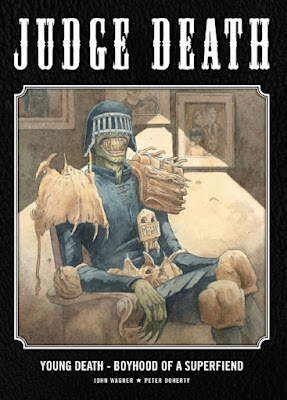(Reprints Judge Death
stories from Judge Dredd Megazine
#1.01-1.12 and Judge Dredd Mega Special 1991)
Yes, we've covered this book before--mostly. "Young
Death" was indeed reprinted in Judge Death: The Life and Death Of..., which David Brothers and I discussed
in November. But the British edition of Young Death includes one bonus story: "Masque of the Judge,
Death," a ten-page black-and-white number by Si Spencer and John McCrea
(set during "Necropolis") that first appeared in the Judge
Dredd Mega Special 1991, published roughly
at the same time as 2000 AD Prog
733. (It was also reprinted in 1999's Best of Judge Dredd Special
Edition, an odds-and-ends collection of
mostly mid-'90s material.)
As its title suggests, its plot is lifted fairly directly
from Edgar Allan Poe's "Masque of the Red Death," and so is a lot of
its language, although substituting pop-culture and Dredd-continuity references
for Poe's descriptions doesn't help them much. "The prince had provided
all the appliances of pleasure. There were buffoons, there were improvisatori,
there were ballet-dancers, there were musicians, there was Beauty, there was
wine," goes the original; Spencer turns that into "There was tobacco,
there was Umpty Candy, there was sugar..." For the benefit of younger
folks reading this blog, the "you're bending my cantaloupe" bit is a
reference to this 1990
Happy Mondays hit, a cover of this John Kongos song
from 1971.
The notable thing about "Masque" is John McCrea's super-high-contrast
black-and-white artwork--some of the most heavily stylized art that had yet
been seen in any Dredd-related story, and also a real outlier in McCrea's
published work, at least the parts of it I've seen. (It doesn't even look much
like the "Chopper" serial he'd published a bit earlier.) That
particular Mega Special had a lot of
visuals that pushed at the edges of what was permissible for the franchise: it
also included Glynn Dillon's curious "Cult of the Thugee" and Shaky
Kane's "Judge Planet." Dean Ormston, who's credited with the idea for
"Masque," drew the image of Judge Death on its cover. Why does it say
"Skreemer," the title of a Peter Milligan/Brett Ewins/Steve Dillon
miniseries DC had published a couple of years earlier? Beats me!
"Masque," though, looks unusual even in that
context. Dredd had never had much in the
way of freehand panel borders (aside from the very different way Carlos
Ezquerra used them), but McCrea's slabs of black nearly look like they're cut
out of construction paper with an unruled X-Acto blade. I love the way he uses
light and space throughout the story, and wish (a little) that he'd continued
to do more art in this vein, as opposed to the more streamlined, straight-ahead
style he developed for The Demon
and Hitman a few years later.
See, for instance, on the page below, the way Prospero's scroll in panel 3 does
the old "sticking out of the panel border" trick via negative
space, or the feathering on "Tweak"'s costume--an effect to be seen
nowhere else on the page or in the story--whose shift to straighter contours
just below its head makes it clear that it's a person in a Tweak outfit.
It's hard to imagine a story that looked like
"Masque" having run in 2000 AD, or
any of its spinoffs, even a couple of years before this. The late
Fleetway/Maxwell period of the series seems to have been even more open to
stylistic experimentation than usual: see also Steve Sampson's work on
"Brit-Cit Babes" and Roger Langridge's "The Straitjacket
Fits." And McCrea's work here would have probably looked
"off-model" if it had been an actual Judge Dredd story, but for a
piece like this that's more about mood than continuity, it's wonderful.
Next week, it's back to the Complete Case Files (after seven weeks away!) with Vol. 16, in which
John Wagner puts in a couple of brief appearances before leaving the weekly
series in Garth Ennis's hands, and over in the Megazine Alan Grant introduces Raptaur and Psi-Judge Karyn.



Thanks for taking time and effort to do this, Wolk. It's rare to find something that gives this material the attention and respect it deserves. I'm just amazed you can do this every week.
ReplyDeleteThe amount of time and attention John Wagner has devoted to his own creation has varied considerably over the years, and The Complete Case Files is headed into some treacherous territory. But I'm with you, Wolk; through [i]Wilderlands[/i], through [i]Doomsday[/i], even through Mark fucking Millar.